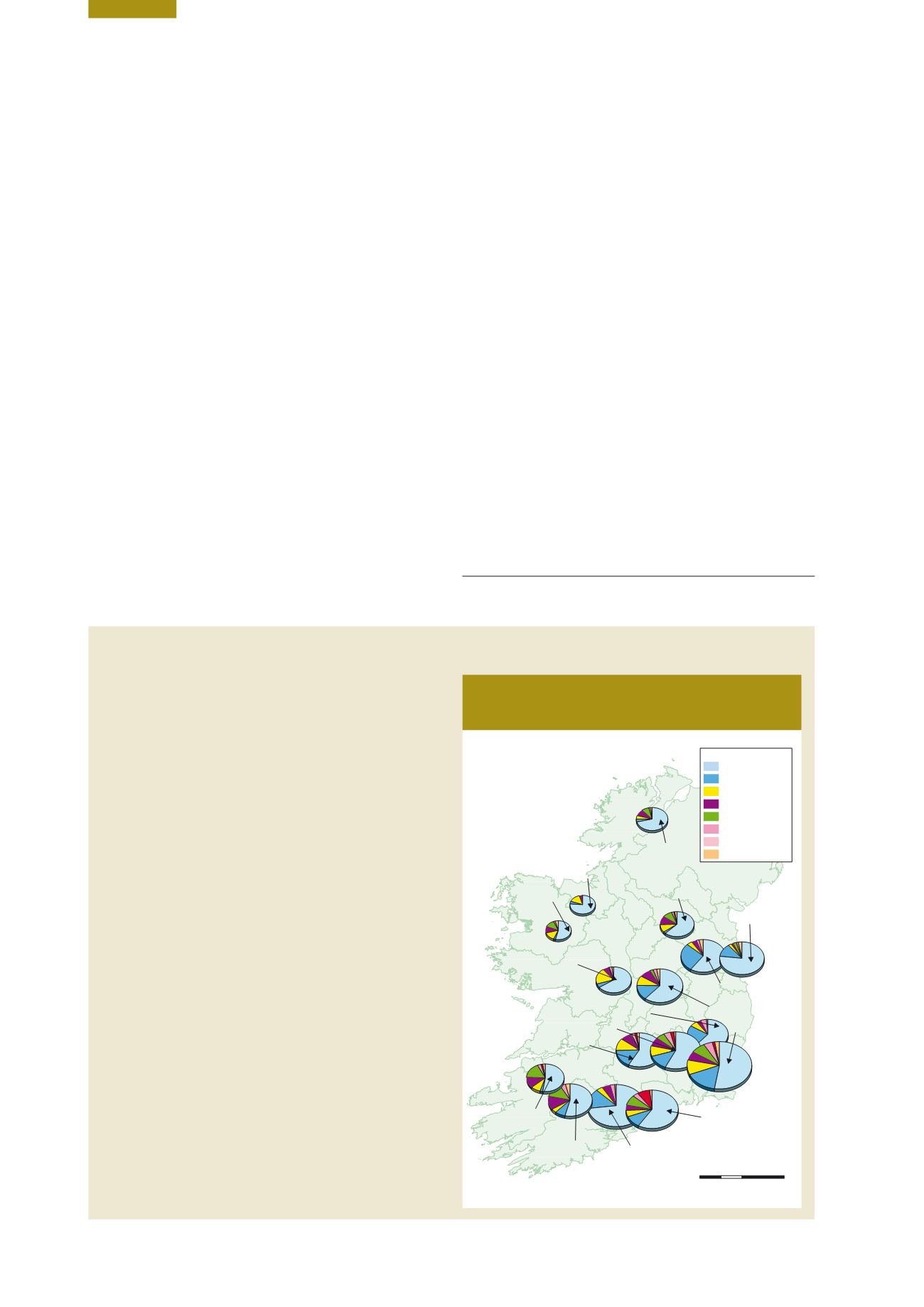

Ireland’s Environment – An Assessment 2016
196
are its microbiological parameters and, in particular,
E. coli
and
Cryptosporidium.
In 2014, 187,804 people
on 36 public water supplies were identified to be at
risk from
Cryptosporidium.
Read
et al.
(2015) found
that Cryptosporidium contamination of drinking water
catchments in Ireland is widespread and probably mainly
of animal origin. However, the majority of the species
found are considered of low risk to public health. Of the
species and genotypes described to date, at least eight
can infect humans, with three being considered major
human pathogens:
Cryptosporidium hominis
,
C. parvum
and
C. meleagridis
. While
C. hominis
is largely restricted to
humans,
C. parvum
has been reported from a large range
of mammals and is very prevalent in young ruminants.
The third species,
C. meleagridis
, is primarily an avian
parasite that occasionally infects humans. The study also
found a positive relationship between rainfall events in the
catchment and
Cryptosporidium
in the raw water supply,
with oocyst numbers higher just after a rainfall event.
The water safety plan approach to managing drinking
water supplies, which is advocated by the World Health
Organization, aims to minimise the potential for entry of
contaminants into water at source through catchment
protection, rather than just depending on having them
removed via treatment at a water treatment plant.
This requires a catchment-based approach including
information, education, stakeholder engagement and
enforcement. Measures currently in place under the
nitrates regulations and cross compliance can contribute
to reducing microbial contamination of water. New
targeted measures introduced under the 2014-2020
Rural Development Programme will also contribute. For
example, the inclusion within GLAS
10
of actions to fence
waters from cattle access protects biodiversity and reduces
direct microbial inputs to waters and, therefore, the risk of
microbial contamination of source drinking waters.
10
www.agriculture.gov.ie/farmerschemespayments/glas/Farm Hazardous Waste Collection
A successful joint initiative to facilitate the
collection, recovery and disposal of hundreds of
tonnes of hazardous waste from farms.
The EPA, Teagasc, the Department of Agriculture,
Food and the Marine, local authorities and waste
contractors all collaborated in 2013 and 2014 in a
joint initiative to facilitate the collection, recovery and
disposal of farm hazardous waste. The campaign was
extensively advertised and promoted by many of the
project partners including Irish Farmers’ Association,
Irish Creamery Milk Supplier Association, Bord Bia, the
Irish Farm Film Producers Group, some agricultural co-
operatives and agricultural merchants.
Nearly 3000 farmers used the collection centres and a
total of 264 tonnes of farm hazardous waste and 100
tonnes of waste electronic and electrical equipment
and batteries were collected (figure 12.8). The main
hazardous waste types presented were engine and
hydraulic oil and filters, pesticides, paint, veterinary
medicines, and needles and contaminated empty
containers. The 32 tonnes of pesticides included
insecticides, fungicides and herbicides including many
that are extremely toxic to both human health and
the environment. Farmers paid for the service, which
confirms clearly that farmers want to manage these
wastes in an appropriate manner and are willing to pay
for the safe recovery and disposal of these wastes where
a service exists.
Figure 12.8
Map of Farm Hazardous Waste
Collections – Locations and Quantities (Source: EPA)
Waste Oil
Pesticides
Paint
Vet Meds and needles
Drums 25 and 205L
Oil Filters
Corrosives
Other Haz Waste
Type of Waste
Balla
5,713 (kg)
Lusk
17,013 (kg)
Thurles
18,424 (kg)
Midleton
28,347 (kg)
Ballymote
5,594 (kg)
Dungarvan
23,654 (kg)
Abbeyfeale
12,219 (kg)
Kilkenny City
21,968 (kg)
Ballyjamesduff
10,013 (kg)
Raphoe
8,496 (kg)
0
60
120
30
Km
©OrdnanceSurvey Ireland.All rights reserved.
LicenceNumberEN 0059208
Ballinasloe
10,773 (kg)
Trim
17,024 (kg)
Tullamore
18,089 (kg)
Enniscorthy
35,958 (kg)
Kanturk
16,792 (kg)
Tullow
14,310 (kg)


















